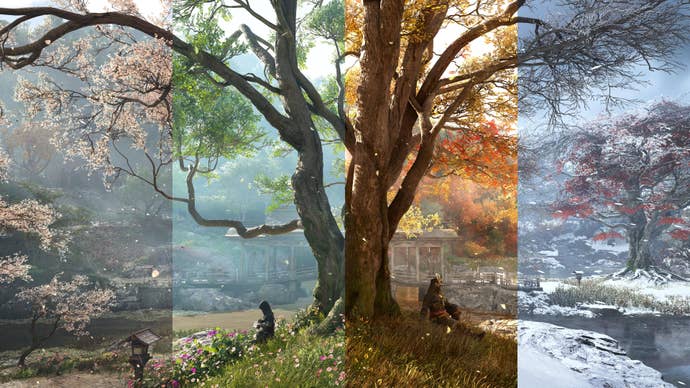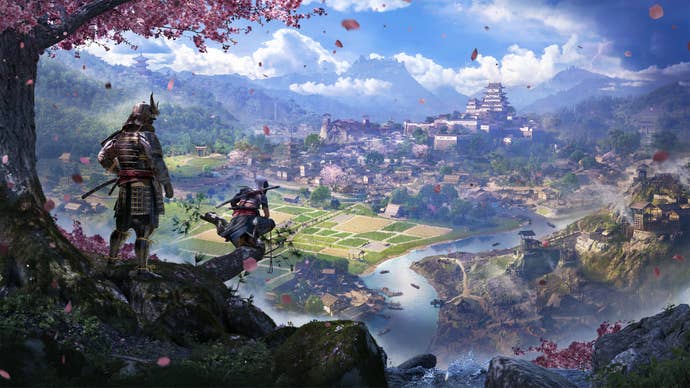Assassin’s Creed Shadows has got one massive, gorgeous, secret weapon up its sleeve to make it more immersive than ever: clouds
Shadows is the first Assassin’s Creed game that has been specifically designed for the PS5 and Xbox Series X/S consoles - and, boy, does it show.
In an open world game, clouds take up a quarter of the screen at all times. They’re massive, important, and - all too often - completely overlooked. I can list a few of my all-time favourite in-game worlds (Destiny, The Witcher 3, Bloodborne, to name a few), and you know what they all have in common? Gorgeous skyboxes that do so much to help fold you into the fiction you’re playing; god rays and weather systems and a sense of scale that firmly roots you in whatever make-believe setting you’re playing in today.
But Assassin’s Creed Shadows isn’t make-believe. Not fully, anyway. As is now tradition for the series, Ubisoft is transporting you back in time, to a real historical location and time period, rooting this fantasy, very much, in reality. This time, we’re off to late-Sengoku period Japan, exploring the central regions of Kobe, Kyoto, and Osaka in 1579 as civil war threatens to choke the life out of this blossoming empire.
Like Mirage, Valhalla, Odyssey and Origins before it, Shadows is keen to project an idealised version of its setting to us - it’s not going to be a perfect, to-scale version of Japan, no. That would be a ludicrous undertaking. Instead, Ubisoft will be cherry-picking the most aesthetically- and mechanically-rewarding elements of the region, crunching them down to a scale that isn’t too overwhelming for your average Open World Enjoyer, and serving them up in a mouth-watering digital package that we can spent 100s of hours gawking at (that’s roughly the size of Origins, by the way).
During a presentation given by art director Thierry Dansereau at Gamescom 2024, I got to see just how much effort Ubisoft has put into this game’s art direction. Dansereau knows how to build a world; he’s been with Ubisoft since Assassin’s Creed Brotherhood, and was art director for Revelations, Syndicate, and Odyssey (the latter being my favourite AssCree setting of the lot).

But, utlising a shiny new version of the Anvil engine, Shadows has one particular trick up its sleeve that can really set it apart from the other games in the series: clouds. Simulated and rendered by a new tool Ubisoft has developed within Anvil - called Atmos - the clouds in Shadows look, behave, and affect the game differently to what you’re used to in AssCree games in the past.
“From an art point of view, skies represent a major visual element that greatly contributes to the perceived visual quality and level of immersion,” Dansereau explains to me when I ask why so much effort has been put into making Anvil deliver realistic, believable clouds for this game. “Having clouds that look realistic in their shapes and behaviors was important to support our ambitions of a dynamic world that is in constant transformation.”
It’s not just an aesthetic thing, either. There are actual gameplay implications to how the clouds look and behave in Ubisoft’s version of 16thC Japan. “In AC Shadows, the entire weather is simulated, which means that the clouds are dynamic, and they evolve over time,” Maxime Beaudoin, tech lead on AC Shadows, tells me. “[...] Atmos not only drives the clouds that you see in the sky, but the entire weather as well (precipitations, wind, wetness accumulation on the ground, thunder strikes, etc). And, in turn, those parameters affect gameplay. For example, during a storm, NPCs have a harder time detecting the player because of the noise and reduced visibility.”

To put it simply, then, Ubisoft is letting Atmos ‘think’ about what the weather should be like across Japan - and rightly so, the island nation is known for its dramatic skies, changeable seasons, and gorgeous vistas. Shadows is the first Assassin’s Creed game to feature a proper seasonal cycle, taking us through spring, summer, fall, and winter, and - as such - Ubisoft needed to make sure all that open sky at the top of your screen was correctly reflective of the world around you.
So, instead of taking artists hundreds of man hours to manually sculpt these skyboxes and ‘paint’ the clouds, Ubisoft lets Atmost calculate the humidity, temperature, and density of water vapor in the air, and spit out the correct weather for the time and season.
“Artists tweak a few parameters, and a cloudscape emerges automatically,” continues Beaudoin. “This means that they don’t control the exact shape of the clouds like in previous games; instead, they focus on the composition, determine the overall look they want to achieve and let the simulation fill in the gaps. This makes it possible to create a very realistic looking cloudscape in a matter of minutes. “
The thing is, as any dev will tell you, simulations are typically difficult to work with: artists need to be very careful, because one wrong number may completely break what you’re working with. As Beaudoin tells me, “in the past, it’s often a trial-and-error process.”
But with Atmos, Ubisoft managed to make a powerful tool - not just some shiny, unwieldable tech demo. “It’s a ‘photoshop of weather’, if you like,” says Beaudoin.

“One way to think about it is the way brushes work in modern digital painting tools: the software simulates the interaction between the canvas, the brush and the paint. Contrast this with pixel art, where the color of every single pixel is fully controlled by the artist - Atmos is like the former rather than the later; we forgo a bit of control, but what we get in return is efficiency, realism and coherence.”
The result? I cannot tell you how amazing Shadows looks. I am what my friends politely call “a cloud perv” in real life; pointing out systems moving in over my home in London, taking trips to the seaside to see ‘rare clouds’ meet and merge and metamorphosize, frequently getting snaps from mates in group chats with a request for identification and explanation. Shadows, I am confident in saying, is the biggest treat a “cloud perv” could ask for; at once beautiful and relevant to how the open world works. It is, quite literally, a game-changer.
“Traditional skyboxes will still be relevant for years to come, but simulated systems like Atmos will likely be used more and more, if not for the simple fact that an experienced artist can create a very realistic and dynamic skybox in a very short amount of time,” says Beaudoin.

“Shadows will be the first Ubisoft game to ship with Atmos, but we barely scratched the surface of what’s possible to do with it. It’s such a different way to do things that we’re still learning how to use it at its best, so you can expect future titles to take advantage of it in much more depth.”
Assassin’s Creed Shadows launches November 15 on PC, PS5, and Xbox Series X/S.







